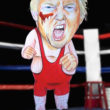“Mitt Romney takes his religion seriously, and he won’t let us know that,” a Mormon scholar told me. “He goes quiet, or dark, on the issue of religion.”
Romney not only avoids discussing Mormonism, he rarely discusses his personal history with the church. Most Mormon men end their official connection to the church when they complete their two-year mission, which begins when they are 19. Although The New York Times wrote about it in October 2011, Romney’s tenure as a bishop—and later a stake president, the highest-ranking member of the Mormon church, in the Boston area—goes largely unmentioned by the media and by the candidate. (Stakes are ecclesiastical subdivisions named after the stakes that sustained the tents of Zion.)
Mormon bishops coordinate religious services at temples. They have authority to perform the sacraments and are responsible for the pastoral care of the sick, troubled, or grieving. They also handle excommunications. Stake presidents have broader authority over several congregations or “wards.” Both positions are unpaid. And both are demanding.
Romney took his administrative and pastoral responsibilities seriously. While he was the bishop in Belmont, a town 10 miles west of Boston, Romney presided over the planning and construction of a new meeting house, according to the feature in The New York Times. As stake president, he served as a mediator between church
leaders in Salt Lake City and local residents concerned about the scale of a temple that was ultimately built in Belmont.
Romney was also devoted to his pastoral duties.
The Times story includes an account of Romney opening his home to minister to a 19-year old college student struggling with drug abuse and alcoholism. The man, now in his thirties, told the Times that Romney refused to judge him, instead telling him that if he was trying to improve and trying to do better, “then you are a saint.”
The Times profile also includes an account from a forthcoming book by Mormon journalist (and Romney’s distant cousin) Ron Scott. A married mother of four was preparing to terminate a pregnancy on the advice of doctors, given the potentially dangerous complications of a blood clot.
Mormons oppose abortion except in cases of rape, incest, or a threat to the life of the mother. When Bishop Romney learned of his congregant’s decision, he showed up at her hospital room uninvited and sternly warned that she should not go through with the abortion.
“Mitt has many, many winning qualities,” the woman that Romney counseled told Scott. “But at the time he was blind to see me as a human being.”
All of this — in particular the account of trying to stop a woman from going through with an abortion— is a campaign narrative that would resonate with a deeply religious Republican base at odds with women’s reproductive rights. If only Romney could tell the story without using the word “Mormon.”
Romney’s circumspection regarding his belief — in his big 2008 speech on faith in public life, he said “Mormon” only once — is more than clever politics. It is what Romney has to do to pass the religious test in the Republican primary.
Evangelicals are a critically important part of the GOP base. And many evangelicals consider Mormonism so far from the mainstream that when they attack the Church of Jesus Christ of Latter-day Saints, they dispense with the piety that constrains their attacks on other faiths (except Islam).
Examples?
Going into the 2008 presidential primary, Mike Huckabee, an ordained Southern Baptist minister (and at the time a candidate for the presidency), said that Mormons believe that Jesus and Satan were brothers.
In October, Robert Jeffress, a Rick Perry supporter and pastor of the First Baptist Church of Dallas, questioned Romney’s religious bona fides. “Do we want a candidate who is a good, moral person, or one who is a born-again follower of the lord Jesus Christ?” Jeffress asked, when he introduced Perry at a Values Voters Summit in Washington. Jeffress later told reporters that Mormonism is a “cult.”
In January, 150 evangelicals met at a ranch near Houston to endorse a candidate. The outcome was predictable. A poll conducted by the Pew Center two months earlier had found that more than half of white evangelical Protestants did not consider Mormonism a Christian faith. And the evangelicals had come together with the unstated intent to stop Romney. On a third ballot, 85 of the 114 votes cast went to Rick Santorum, the remaining 29 to Newt Gingrich.
Aversion to Latter-day Saints, in fact, is almost a national pastime. A Public Religion Research Institute survey last year found that 42 percent of Americans would be very uncomfortable or somewhat uncomfortable voting for a Mormon president.
In American Grace, authors Robert D. Putnam and David E. Campbell describe Mormons as the “third most-hated” denomination in the U.S. — behind Muslims and Buddhists. (Who can hate Buddhists?)
All of this suggests two obvious questions. What did Mormons do to alienate their fellow Christians? And should enlightened voters beyond the circumscribed world of evangelicals be concerned with Romney’s personal belief?
The saints, as Mormons call themselves, are currently $10 million into a national “I’m a Mormon” ad campaign — which is hard to miss if you have turned on a television, looked at a billboard, or used public transportation in most major cities in the country.
The campaign is based on surveys and focus groups conducted by two big, secular public relations firms. The firms found that Mormons are considered “secretive,” “cultish,” “sexist,” “controlling,” “pushy,” and “anti-gay.”
In fact, Mormonism is secretive and controlling, something an ad campaign is not likely to change.
For example, Mormonism is the only major denomination that closes its temples to non-adherents. In fact, before a Mormon can attend religious services in his own temple, he must obtain a “temple recommend” from a bishop, responding to a list of questions that includes: an oath of loyalty to the president of the church as a prophet, seer, and revelator; a commitment to chastity; a promise to tithe; and an agreement to wear temple garments (sanctioned underwear) day and night and to observe dietary rules.
As a result of the closed temples, the public is left to speculate about secret rituals, such as the baptism of the dead and the sanctioning of polygamy in the afterlife (if the latter is actually a practice.) And a Mormon candidate for the highest office in the land becomes the face of a religion that many Americans consider kind of weird.
Kathleen Flake is a professor who teaches American religious history at Vanderbilt University. She’s also a Mormon. I asked her if she saw aversion to Latter-day Saints as a drag on Romney’s candidacy. “Mormonism, his faith, his religion, is strange to many Americans,” Flake said. “To many Americans it is not an acceptable, modern religion. And it is the kind of religion about which you would say ‘that person is too religious.’ ”
Flake said that while evangelicals are hostile to Romney because he belongs to the wrong religion, other voters are more likely to be concerned because Romney is too religious.
“He is deeply invested in the faith,” Flake said. “With this guy, it goes to his bones.”
SIDEBAR: A ROMNEY TIMELINE
A few highlights from the candidate’s life as an LDS: 1965: Romney and Ann Davies begin dating and inform their parents they have agreed to marry after Mitt’s college education and Mormon mission. While Romney is away at college, George Romney persuades the teenage Davies to take classes at the Mormon tabernacle near the Romney home in Bloomfield, Michigan, where she will convert.
1966: Romney arrives in France for missionary work in the south. He has often descried how lonely and isolated he was in the Bordeaux Region, trying to convert the French to a foreign faith that bans alcohol.
1968: Romney witnesses and is horrified by the leftist student-worker uprising of May 1968. While driving the wife of the chief Mormon missionary in France, another driver slams into his car, killing Romney’s passenger and severely injuring him. French police assign blame to the other driver. Romney has described how the accident changed him, showing him the fragility of life. After the grieving husband named Romney Section Chief in Bordeaux, Romney claimed that he rallied the faithful — after the accident and the demoralizing leftist demonstrations — to convert a record 200 French to the Mormon faith.
1981: Romney is named bishop and subsequently stake president (similar to the head of a diocese), becoming the highest-ranking Mormon cleric in Boston.
1990: Exponent II, a Mormon feminist magazine, published an article by a mother who said Romney visited the hospital to warn her not to terminate her pregnancy when she was being treated for a risky blood clot.






0 Comments